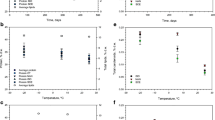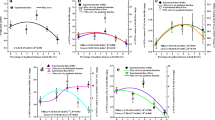Abstract
As one of the key ingredients in feed for rearing salmon the stability of the synthetic feed pigment Carophyll Pink® (CP) and the natural pigment Panaferd-AX® (PAN) in pure cod liver oil were investigated. As reference, pure cod liver oil without added carotenoids was used (PURE). Carotenoid content, isomerization of astaxanthin in CP and distribution of carotenoids in PAN and the antioxidant ability of CP and PAN were followed by HPLC in two model experiments (Experiment 1: 17 days, temperature 18.5–28.2 °C, and Experiment 2: 15 days, temperature 29.7 °C). Moreover, peroxide value (PV), thiobarbituric value (TBARS) and fatty acid (FA) compositions were analyzed in CP, PAN and PURE. Relative to cod liver oil with added PAN, addition of CP resulted in significantly higher stability of ∑PUFA, slower formation of peroxides, reduced oxidation and increased carotenoid stability during storage. For the isomerization of astaxanthin in CP a significantly decrease in all-E-astaxanthin and an increase in 13Z-astaxanthin was observed during storage in both experiments. Highest stability of different carotenoids in PAN were found for the carotenoid β-carotene in both experiments, followed by echinenone and astaxanthin in Experiment 1 and astaxanthin, adonirubin and adonixanthin in Experiment 2. It is concluded that the synthetic pigment feed additive CP significantly improves the stability of cod liver oil as compared to the natural pigment feed additive PAN (order of stability; CP > PAN > PURE).



Similar content being viewed by others
References
Lorenz RT, Cysewski GR (2000) Commercial potential for Haematococcus microalgae as a natural source of astaxanthin. Trends Biotechnol 18:160–167
Terao J (1989) Antioxidant activity of beta-carotene-related carotenoids in solution. Lipids 24:659–661
Mortenson A, Skibsted lH (2000) Antioxidant activity of carotenoids in muscle foods. In: Decker E, Faustman C, Lopez-Bote CJ (eds) Antioxidants in muscle foods. Wiley, New York, pp 61–83
Palozza P, Krinsky NI (1992) Antioxidant effects of carotenoids in vivo and in vitro: an overview. Methods Enzymol 213:403–420
Stahl W, Sies H (2003) Antioxidant activity of carotenoids. Mol Aspects Med 24:345–351
Miki W (1991) Biological functions and activities of animal carotenoids. Pure Appl Chem 141
Maoka T, Yasui H, Ohmori A, Tokuda H, Suzuki N, Osawa A, Shindo K, Ishibashi T (2013) Anti-oxidative, anti-tumor-promoting, and anti-carcinogenic activities of adonirubin and adonixanthin. J Oleo Sci 62:181–186
Hussein G, Sankawa U, Goto H, Matsumoto K, Watanabe H (2006) Astaxanthin, a carotenoid with potential in human health and nutrition. J Nat Prod 69:443–449
Ranga Rao A, Raghunath Reddy RL, Baskaran V, Sarada R, Ravishankar GA (2010) Characterization of microalgal carotenoids by mass spectrometry and their bioavailability and antioxidant properties elucidated in rat model. J Agric Food Chem 58:8553–8559
Haila K, Heinonen M (1994) Action of β-carotene on purified rapeseed oil during light storage. LWT Food Sci Technol 27:573–577
Haila KM, Lievonen SM, Heinonen MI (1996) Effects of lutein, lycopene, annatto, and γ-tocopherol on autoxidation of triglycerides. J Agric Food Chem 44:2096–2100
Østerlie M, Bjerkeng B, Liaaen-Jensen S (2002) Antioxidant effects of astaxanthin E/Z-isomers in cod liver oil and in ethyl esters of polyunsaturated fatty acids. In: 13th International carotenoid symposium, Honolulu, Hawaii, pp 61
Martin H-D, Jäger C, Ruck C, Schmidt M, Walsh R, Paust J (1999) Anti- and prooxidant properties of carotenoids. J für praktische Chemie 341:302–308
Jensen C, Birk E, Jokumsen A, Skibsted LH, Bertelsen G (1998) Effect of dietary levels of fat, α-tocopherol and astaxanthin on colour and lipid oxidation during storage of frozen rainbow trout (Oncorhynchus mykiss) and during chill storage of smoked trout. Z Lebensm Unters Forsch 207:189–196
Johnston IA, Li X, Vieira VLA, Nickell D, Dingwall A, Alderson R, Campbell P, Bickerdike R (2006) Muscle and flesh quality traits in wild and farmed Atlantic salmon. Aquaculture 256:323–336
Alfnes F, Guttormsen AG, Steine G, Kolstad K (2006) Consumers’ willingness to pay for the color of Salmon: a choice experiment with real economic incentives. Am J Agric Econ 88:1050–1061
Nguyen KD (2013) Astaxanthin: a comparative case of synthetic vs. natural production. Chem Biomol Eng Other Works. http://trace.tennessee.edu/utk_chembiopubs/94
Nickell DC, Springate JRC (1999) Pigmentation of farmed salmonids. In: International Conference on Farmed Fish Quality. Blackwell Science, Oxford Science, Bristol
Schmidt I, Schewe H, Gassel S, Jin C, Buckingham J, Humbelin M, Sandmann G, Schrader J (2011) Biotechnological production of astaxanthin with Phaffia rhodozyma/Xanthophyllomyces dendrorhous. Appl Microbiol Biotechnol 89:555–571
Choubert G, Mendes-Pinto MM, Morais R (2006) Pigmenting efficacy of astaxanthin fed to rainbow trout Oncorhynchus mykiss: effect of dietary astaxanthin and lipid sources. Aquaculture 257:429–436
Choubert G, Milicua J-C, Gomez R, Sancé S, Petit H, Nègre-Sadargues G, Castillo R, Trilles J-P (1995) Utilization of carotenoids from various sources by rainbow trout: muscle colour, carotenoid digestibility and retention. Aquacult Int 3:205–216
Sanderson GW, Jolly SO (1994) The value of Phaffia yeast as a feed ingredient for salmonid fish. Aquaculture 124:193–200
EFSA (2007) Safety and efficacy of Panaferd-AX (red carotenoid-rich bacterium (Paracoccus carotinifaciens) as feed additive for salmon and trout. The EFSA J 1–30
Østerlie M (2000) Næringsmiddelkjemiske studier av astaxanthin isomere. Department of Chemistry, Norwegian University of Science and Technology (NTNU), Trondheim
Rossel JB (1989) Measurement of rancidity. In: Allen JC, Hamilton RJ (eds) Rancidity in foods. Elsevier, London
Springate JRC, Nickell DC (2000) Astaxanthin for aquaculture: CAROPHYLL_ Pink Since 1985. F. Hoffman-La Roche Ltd, Basel
Metcalfe LD, Schmitz AA, Pelka JR (1966) Rapid preparation of fatty acid esters from lipids for gas chromatographic analysis. Anal Chem 38:514–515
Britton G (1995) UV/VIS spectroscopy. In: Britton G, Liaaen-Jensen S, Pfander H (eds) Carotenoids, vol 1B., Spectroscopy. Birkhäuser, Basel, Switzerland, pp 13–62
Vecchi M, Glinz E, Meduna V, Schiedt K (1987) HPLC separation and determination of astacene, semiastacene, astaxanthin, and other keto-carotenoids. J High Resolut Chromatogr 10:348–351
Schüep W, Schierle J (1995) Example 9: Astaxanthin. In: Britton G, Liaaen-Jensen S, Pfander H (eds) Carotenoids, vol 1B., Spectroscopy. Birkhäuser, Basel, pp 273–276
Shantha NC, Decker EA (1994) Rapid, sensitive, iron-based spectrophotometric methods for determination of peroxide values of food lipids. J AOAC Int 77:421–424
Ke PJ, Woyewoda AD (1979) Microdetermination of thiobarbituric acid values in marine lipids by a direct spectrophotometric method with a monophasic reaction system. Anal Chim Acta 106:279–284
Gunstone FD (1984) Reaction of oxygen and unsaturated fatty acids. J Am Oil Chem Soc 61:441–447
CRN (2002) Voluntary monograph. Omega-3 DHA omega-3 DHA and EPA. Council for Responsible Nutrition, Washington DC
CE (2008) European pharmacopoeia 6th edition. Supplement 6.3. Council of Europe, Strasbourg
Budilarto ES, Kamal-Eldin A (2015) Stabilization of cod liver oil with a quaternary combination of α-tocopherol and synergists: Method of assessment, European J Lipid Sci and Technol. doi:10.1002/ejlt.201400637
Maoka T, Etoh T, Osawa A, Shindo K (2012) Characterization and singlet oxygen quenching activity of (3R)-3-hydroxy-4-ketotorulene and (3R)-3-hydroxy-4-keto-gamma-carotene isolated from the yeast Xanthophyllomyces dendrorhous. J Oleo Sci 61:401–406
Osawa A, Ishii Y, Sasamura N, Morita M, Kasai H, Maoka T, Shindo K (2010) Characterization and antioxidative activities of rare C(50) carotenoids-sarcinaxanthin, sarcinaxanthin monoglucoside, and sarcinaxanthin diglucoside-obtained from Micrococcus yunnanensis. J Oleo Sci 59:653–659
Boon CS, McClements DJ, Weiss J, Decker EA (2010) Factors influencing the chemical stability of carotenoids in foods. Crit Rev Food Sci Nutr 50:515–532
Naguib YM (2000) Antioxidant activities of astaxanthin and related carotenoids. J Agric Food Chem 48:1150–1154
Mortensen A, Skibsted LH, Sampson J, Rice-Evans C, Everett SA (1997) Comparative mechanisms and rates of free radical scavenging by carotenoid antioxidants. FEBS Lett 418:91–97
Bjerkeng B, Følling M, Lagocki S, Storebakken T, Olli JJ, Alsted N (1997) Bioavailability of all-E-astaxanthin and Z-isomers of astaxanthin in rainbow trout (Oncorhynchus mykiss). Aquaculture 157:63–82
Levin G, Mokady S (1994) Antioxidant activity of 9-cis compared to all-trans beta-carotene in vitro. Free Radic Biol Med 17:77–82
Levin G, Yeshurun M, Mokady S (1997) In vivo antiperoxidative effect of 9-cis beta-carotene compared with that of the all-trans isomer. Nutr Cancer 27:293–297
McMurry J (1992) Alkenes: structure and reactivity. In: McMurry J (ed) Organic chemistry. Brooks/Cole, Belmont, pp 186–189
Gao G, Wei CC, Jeevarajan AS, Kispert LD (1996) Geometrical isomerization of carotenoids mediated by cation radical/dication formation. J Phys Chem 100:5362–5366
Ben-Amotz A, Shaish A, Avron M (1991) The biotechnology of cultivating Dunaliella for production of β-carotene rich algae. Bioresour Technol 38:233–235
Rønnekleiv M, Liaaen-Jensen S (1992) Bacterial carotenoids 52. C50-Carotenoids 22. Naturally occurring geometrical isomers of bacterioruberin. Acta Chem Scand 46:1092–1095
Strand A, Shivaji S, Liaaen-Jensen S (1997) Bacterial carotenoids 55. C50-carotenoids 25. † revised structures of carotenoids associated with membranes in psychrotrophic Micrococcus roseus. Biochem Syst Ecol 25:547–552
Etoh H, Suhara M, Tokuyama S, Kato H, Nakahigashi R, Maejima Y, Ishikura M, Terada Y, Maoka T (2012) Auto-oxidation products of astaxanthin. J Oleo Sci 61:17–21
Acknowledgments
The authors wish to thank Orkla Health Dep. Denomega, Leknes, Norway for the supply of cod liver oil. We also want to thank the students Mia Holvik and Fredrik Flatjord Nilsen together with the staff at Sør-Trøndelag University College for excellent technical support.
Author information
Authors and Affiliations
Corresponding author
About this article
Cite this article
Østerlie, M., Lerfall, J. Pigments for Aquaculture of Salmonids. A Comparative Model Study of Carophyll Pink and Panaferd AX in Cod Liver Oil. J Am Oil Chem Soc 92, 1321–1331 (2015). https://doi.org/10.1007/s11746-015-2690-8
Received:
Revised:
Accepted:
Published:
Issue Date:
DOI: https://doi.org/10.1007/s11746-015-2690-8




